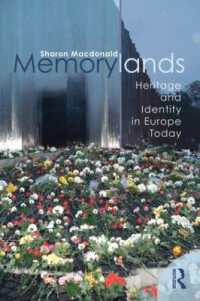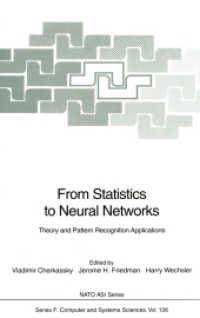- ホーム
- > 洋書
- > 英文書
- > History / World
Full Description
A reassessment of the journey Germans in East and West have taken during the past two and a half decades: even today, an open-ended, unfinished journey.
On October 3, 1990, just a year after the Berlin Wall fell, the German Democratic Republic was absorbed into the Federal Republic of Germany, officially ceasing to exist. What was the GDR and how do we remember it? According to the dominant Western narrative, it was a country that brought neither unity nor justice nor freedom to its citizens. But if so, why does a virtual wall still seem to exist in Germany today between the erstwhile citizens of the GDR and FRG? The GDR very much remains in the public debate, and while political integration is well on its way, the cultural integration of the two former states has proven much more challenging.
This volume analyzes the culturaltransformation - or lack thereof - that has followed political unification. The contributions are interdisciplinary: essays on history and politics provide a framework and others on art, film, literature, museums, music, and education provide specific examples. These case studies allow us to examine the state of unification beyond statistics, opinion polls, and glib generalizations. The volume, then, is a reassessment of the journey Germans in East and West have taken during the past two and a half decades. Even today, it is an open-ended, unfinished journey. But such journeys tend to be the most interesting.
Contributors: Kerstin Barndt, Stephen Brockmann, Michael Dreyer, Andreas Eis, April A. Eisman, Peter Hayes, Franziska Lys, Charles S. Maier, Andreas Niederberger, Mary-Elizabeth O'Brien, Daniel Ortuno-Stühring.
Franziska Lys is Professor of German at Northwestern University. Michael Dreyer is Professor in the Institute for Political Science at the University of Jena.
Contents
Introduction: United Politics-Divided Culture? - Franziska Lys and Michael Dreyer
Lost in Transition: Reflections on the Spectral History of the GDR - Charles S. Maier
Reconstituting the Federal Republic? Constitutional Law and Politics before and since 1989 - Andreas Niederberger
East German Literature and Reunification: Continuities and Discontinuities - Stephen Brockmann
The Afterlife of the GDR in Post-Wall German Cinema - Mary-Elizabeth O'Brien
Exhibiting 1989/2009: Memory, Affect, and the Politics of History - Kerstin Barndt
Reexamining the Staatskünstler Myth: Bernhard Heisig and the Post-Wall Reception of East German Painting - April A. Eisman
East German Orchestras and Theaters: The Transformation since the Wende - Daniel Ortuno-Stühring
What Do German High School Students Think about the GDR? Memory Culture between Glorification and Evaluation - Andreas Eis
The Ongoing Significance of East Germany and the Wende Narrative in Public Discourse - Michael Dreyer
Epilogue: The Wende and the End of "the German Problem" - Peter Hayes
Notes on the Contributors
Index








